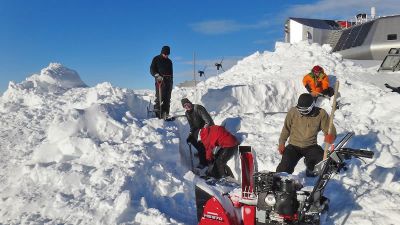
Arrival of the Japanese Scientists
Today, a team of geologists from the National Institute of Polar Research (NIPR) in Tokyo arrived with two tons of material. On top of carrying on with digging out the station, the newcomers had to be welcomed, briefed, fed and shown their quarters.
Once installed, the Japanese researchers decided to participate in the removal of accumulated snow. Armed with shovels, the five men join the Belgian crew and helped them dig out the first tractors. While these were put to good use, the men concentrated on the areas that could not be reached by the big Prinoth's blades, like the solar panels on the technical area's roof.
After the usual twelve hours of work, everybody gathers in the station for supper and conversations start about the future scientific expedition of the Japanese. For their geological research, they will be spending 40 days in the field, 80km away from the station.
Their main objective this year will be to do a geological survey of the Central Sør Rodane Mountains. They will try to determine the age of the various rock formations and analyze the movement of glaciers through these rock formations to link it to climate change. Glaciers go through cycles, receding and rising according to temperatures. By examining the rocks through which they pass, and determining whether these rocks were covered or exposed by glacier movements, scientists can track past temperatures and climate.
Picture: NIPR scientists giving a hand - © International Polar Foundation
